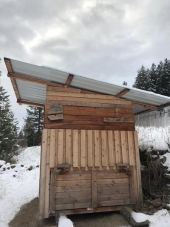I have all the major trees and about half the shrubs planted. I haven't started on any of the lower layers yet, except for one
apple tree guild which is sort of an experiment. Here is the design (which we had done professionally):

The trees I have include:
- Quercus garryana (Oregon White Oak,
native tree for wildlife)
- Acer macrophylum (Bigleaf Maple, source of leaf mulch)
- Acer circinatum (Vine Maple, part of the natives theme, also good fall color - I want my food forest to look nice!)
- Alnus rubra (Red alder, part of natives theme, nitrogen fixer)
- Rhamnus purshiana (Cascara, native tree, berries for birds)
- Corylus cornuta (native hazelnut)
- Hardy almond, 2 varieties
- Several varieties of apple, including one that I grew from seed
- Several varieties of plum
- Several varieties of fig
- American chestnut
- English walnut (almost 3' diameter, was on the property when we bought it, fell over during an ice storm but is still growing well)
- Mulberry (died but I will replace it)
The berries & vines include:
- About 5 varieties of table grape
- Several varieties of hardy kiwi
- Goji, 2 varieties
- Seaberry, 2 varieties
- Chokeberry (Aronia), Red & Black
- Blueberry, about 8 varieties
- Honeyberry, 2 varieties
- Currant
- Serviceberry
- Blackberry/Marionberry, 4 varieties
- Raspberry, 5 varieties
- Rubus occidentalis, native black raspberry
I also have many native shrubs. Originally we were going to have nearly all natives but I have been substituting more and more food plants. Not that I need lots of food plants, I would just like to go out in the
yard any time of year and pick something to eat. If it all works out well, I will offer the surplus up to the
local volunteer gleaners, who take half to the food bank and take half home.
I'll see if I can get a photo of my apple guild. It mainly consists of comfrey, mint and some kind of monster vetch which buries everything else. I am tired of the vetch though.

 1
1








 1
1




 6
6









 1
1




 2
2














